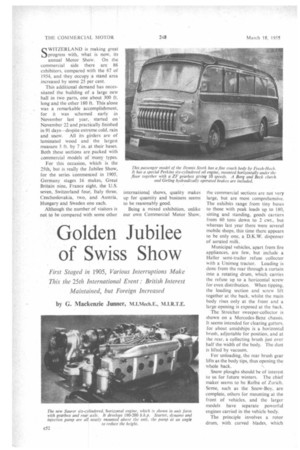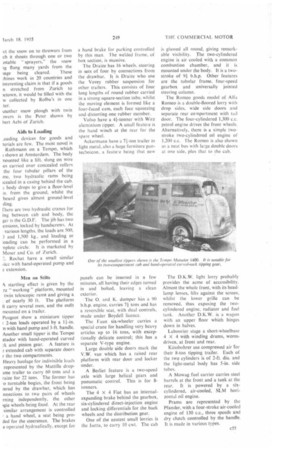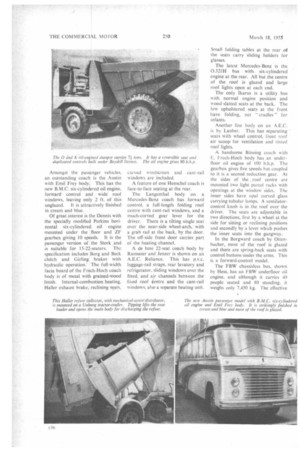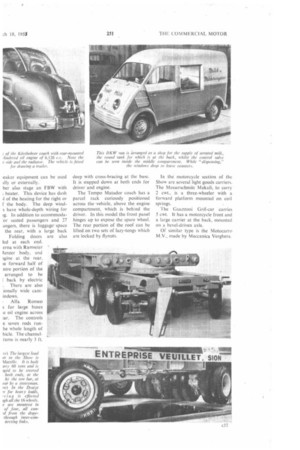Golden Jubilee of Swiss Show
Page 194

Page 197

Page 198

Page 199

If you've noticed an error in this article please click here to report it so we can fix it.
First Staged in 1905, Various Interruptions Make This the 25th International Event : British Interest Maintained, but Foreign Increased
by G. Mackenzie Junner, M.I.Mech.E., M.I.R.T.E. SWITZERLAND is making great progress with, what is now, its annual Motor Show. On the commercial side there are 86 exhibitors, compared with the 67 of 1954, and they occupy a stand area increased by some 25 per cent.
This additional demand has necessitated the building of a large new hall in two parts, one about 300 ft. long and the other 180 ft. This alone was a remarkable accomplishment, for it was schemed early in November last year, started on November 22 and practically finished in 91 days—despite extreme cold, rain and snow. All its girders are of laminated wood and the largest measure 3 ft. by 7 in. at their bases. Both these sections are packed with commercial models of many types.
For this occasion, which is the 25th, but is really the Jubilee Show, for the series Commenced in 1905, Germany stages 16 makes, Great Britain nine, France eight, the U.S. seven, Switzerland four. Italy three, Czechoslovakia, two, and Austria, Hungary and Sweden one each.
Although the number of visitors is not to be compared with some other international shows, quality makes up for quantity and business seems to be reasonably good.
Being a mixed exhibition, unlike our own Commercial Motor Show,
the commercial sections are not very large, but are most comprehensive. The exhibits range from tiny buses to those with peak toads up to 180, sitting and standing, goods carriers from 60 tons down to 2 cwt., but whereas last year there were several mobile shops, this time there appears to be only one, a D.K.W. dispenser of aerated milk.
Municipal vehicles, apart from fire appliances, are few, but include a Haller semi-trailer refuse collector with a Unimog tractor. Loading is done from the rear through a curtain into a rotating drum, which carries the refuse up to a horizontal screw for even distribution. When tipping, the loading section and screw lift together at the back, whilst the main body rises only at the front and a large opening is exposed at the hack.
The Streicher sweeper-collector is shown on a Mercedes-Benz chassis. It seems intended for clearing gutters, for about amidships is a horizontal brush, adjustable for position, and at the rear, a collecting brush just over half the width of the body. The dust is lifted by vacuum.
For unloading, the rear brush gear lifts as the body tips, thus opening the whole back.
Snow ploughs should be of interest to us for future winters. The chief maker seems to be Rolba of Zurich. Some, such as the Snow-Boy, are complete, others for mounting at the front of vehicles, and the larger models have separate powerful engines carried in the vehicle body.
The principle involves a rotor drum, with curved blades, which 'ct the snow on to throwers from ch it shoots through one or two tstable " sprayers," the snow ig flung many yards from the sage being cleared. These :hines work in 20 countries and interesting claim is that if a goods n stretched from Zurich to wtown, it would be filled with the w collected by RoIba's in one ter.
Lnother snow plough with twin awers is the Peter shown by bert Aebi of Zurich,
Aids to Loading
.oading devices for goods and terials are few. The mot novel is Ruthmann on a Tempo, which ; shown at Amsterdam. The body nounted like a lift, slung on wire es carried over concealed rollers the four tubular pillars of the me, two hydraulic rams being icealed in a casing behind the cab. body drops to give a floor-level h. from the ground, whilst the board gives almost ground-level ding,
[-here are two hydraulic cranes for ing between cab and body, the ger is the G.D.F. The jib has two ensions, locked by handscrews. At various lengths, the loads are 500, ) and 1,500 kg., and loading or loading can be performed in a nplete circle. It is marketed by Moser and Co. of Zurich.
Rochat have a small similar /ice with hand-operated pump and e extension.
Men on Stilts k startling effect is given by the rz " working " platform, mounted twin telescopic rams and giving a . of nearly 30 ft. The platform II carry several men, and the oufit mounted on a trailer.
Peugeot show a miniature tipper r 2-ton loads operated by a lf-in.
n with hand pump and 3-ft. handle. Another small tipper is the Tempo atador with hand-operated curved
and pinion gear. A feature is .t extended cab with separate doors r the two compartments.
Heavy haulage for indivisible loads represented by the Mattille dropme trailer trailer to carry 60 tons and a raize for 22 tons. The former has
o turntable bogies, the front being !ered by the drawbar, which has nnections to two pairs of wheels rning independently, the other ■ gie wheels being fixed. At the rear similar arrangement is controlled a hand wheel, a seat being pro[led for the steersman_ The brakes e operated hydraulically, except for a hand brake for parking controlled by this man. The welded frame, of box section, is massive.
The Draize has 16 wheels. steering in sets of four by connections from the drawbar. It is Draize who use the Vevey rubber suspension for other trailers. This consists of four long lengths of round rubber carried in a strong square-section tube, whilst the moving element is formed like a four-faced cam, each face squeezing and distorting one rubber member.
Volvo have a 4i-tonner with Wirz aluminium tipper. A small feature is the hand winch at the rear for the spare wheel.
Ackermann have a 71-ton trailer in light metal, also a huge furniture pantechnicon, a feature being that new panels can be inserted in a few minutes, all having their edges turned in and bolted, leaving a clean exterior.
• The 0. and K. dumper has a 90 b.h.p. engine, carries 7i tons and has a reversible scat, with dual controls, made under Boydell licence.
The Faun six-wheeler carries a special crane for handling very heavy articles up to 16 tons, with exceptionally delicate control; this has a separate V-type engine.
Large doable side doors mark the V.W. van which has a raised rear platform with rear door and locker under.
A Berliet feature is a two-speed axle with large helical gears and pneumatic control. This is for 8boners.
The 4 X 4 Fiat has an internalexpanding brake behind the gearbox, six-cylindered direct-injection engine and locking differentials for the back wheels and the distribution gear.
One of the neatest small lorries is the Isetta, to carry 10 cwt. The cab is glassed all round, giving remarkable visibility. The two-cylindered engine is air cooled with a common combustion chamber, and it is mounted under the body. It is a twostroke of 91 b.h.p. Other features are the tubular frame, four-speed gearbox and universally jointed steering column.
The Romeo goods model of Alfa Romeo is a double-floored lorry with drop sides, wide side doors and separate rear compartment with tail door. The four-cylindered 1.300 c.c. petrol engine drives the front wheels. Alternatively, there is a simple twostroke two-cylindered oil engine of 1,200 c.c. The Romeo is also shown as a neat bus with large double doors at one side, plus that to the cab.
The D.K.W. light lorry probably provides the acme of accessibility. Almost the whole front, with its headlamp lenses, lifts against the screen, whilst the lower grille can be removed, thus exposing the twocylindered engine, radiator and fuel tank. Another D.K.W. is a wagon with an upper floor which hinges down in halves.
Labourier stage a short-wheelbase 4 x 4 with winding drums, wormdriven, at front and rear.
Kassbohrer use compressed air for their 8-ton tipping trailer. Each of the two cylinders is of 2-ft. dia. and the light-metal body has 5-in, side tubes.
A Mowag fuel carrier carries steel barrels at the front and a tank at the rear. It is powered by a sixcylindered, air-cooled, SLM horizontal oil engine.
Prams are represented by the Pfander, with a four-stroke air-cooled engine of 130 c.c., three speeds and dry clutch controlled by the handle. It is made in various types. Amongst the passenger vehicles, an outstanding coach is the Austin with Emil Frey body. This has the new B.M.C. six-cylinclered oil engine. forward control and wide roof windows, leaving only 2 ft. of this unglazed. it is attractively finished in cream and blue.
Of great interest is the Dennis with the specially modified Perkins horizontal six-cylindered oil engine mounted under the floor and ZF gearbox giving 10 speeds. It is the passenger version of the Stork and is suitable for 15-22-seaters. The specification includes Borg and Beck clutch and Girling brakes with hydraulic operation. The full-width facia board of the Frech-Hoch coach body is of metal with grained-wood finish. Internal-combustion heating, Haller exhaust brake,. reclining seats, curved windscreen and cant-rail windows are included.
A feature of one Henschel coach is face-to-face seating at the rear.
The Langenthal body on a Mercedes-Benz coach has forward control, a full-length folding roof centre with cant-rail windows, and a much-curved gear lever for the driver. There is a tilting single seat over the near-side wheel-arch, with a grab rail at the back, by the door. The off-side front door carries part of the heating channel.
A de luxe 22-seat coach body by Ramscier and _Tenzer is shown on an A.E.C. Reliance. This has p,v.c. luggage-rail straps, rear lavatory and refrigerator, sliding windows over the fixed, and air channels between the fixed roof ientre and the cant-rail windows, also a separate heating unit. Small folding tables at the rear of the seats carry sliding holders for glasses.
The latest Mercedes-Benz is the 0.321H bus with six-cylindered engine at the rear. All but the centre of the roof is glazed and large roof lights open at each end.
The only Ikarus is a utility bus with normal engine position and wood-slatted seats at the back. The few upholstered seats at the front have folding, net cradles for infants.
Another fine body on an A.E.C. is by Lauber. This has separating seats with wheel control, front roof air scoop for ventilation and tinted roof lights.
A handsome Bussing coach with E. Frech-Hoch body has an underfloor oil engine of 100 b..b.p. The gearbox gives five speeds hut coupled to it is a second reduction gear. At the sides of the _ roof centre are mounted two light parcel racks with openings at the window sides. The inner sides have opal curved glass carrying tubular lamps. A ventilatorcontrol knob is in the roof over the driver. The seats are adjustable in two directions, first by a wheel at the side for sitting or reclining positions and secondly by a lever which pushes the inner seats into the gangway.
In the Borgward coach by Ottenbacher, most of the roof is glazed and there are spring-hack seats with control buttons under the arms. This is a forward-control model.
The FBW chassisless bus, shown by Hess, has an FBW underfloor oil engine, and although it carries 40 people seated and 80 standing, it weighs only 7,450 kg. The effective
,eaker equipment can be used Illy or externally.
ber also stage an FBW with ; heater. This device has dash Ll of the heating for the right or
r the body. The deep wind
s have whole-depth wiring for g. In addition to accornmoda Or seated passengers and 27 angers, there is luggage. space the rear, with a large back Folding doors are also led at each end.
erna with Ramseier Fenzer body, and igine at the rear. ie forward half of Mre portion of the arranged to he back by electric . There are also ionally wide cantindows.
r Alfa Romeo
s for large buses ,e oil engine across ai-„ The controls e seven rods. runhe whole length of hide. The channelrame is nearly 3 ft.
deep with cross-bracing at the base. It is stepped down at both ends for driver and engine.
The Tempo Matador coach has a parcel rack curiously positioned across the vehicle, above the engine compartment, which is behind the driver, in this model the front panel hinges up to expose the spare wheel. The rear portion of the roof can be lifted on two sets of lazy-tongs which are locked by flynuts. In the motorcycle section of the Show arc several light goods carriers, The Messerschmitt Mokuli, to carry 2 cwt., is a three-wheeler with a forward platform mounted on coil springs.
-rhe Guazzoni Grif-car carries 5 cwt. It has a motorcycle front and a large carrier at the back, mounted on a bevel-driven axle.
Of similar type is the Motocarro M.V., made by Meecanica Verghera.








































































































































































































































































